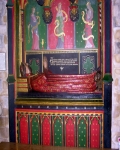church monument
Archaeology »
Archaeological Monuments » church monument
church monument - United kingdom
church monument is located in Southwark, London.
church monument monument was established on 1106-1897.
Primary threats to church monument :
It can take various forms, from a simple wall tablet to a large and elaborate structure which may include an effigy of the deceased person and other figures of familial or symbolic nature.The full name is Cathedral and Collegiate Church of St. Saviour and St. Mary Overie.
Historical facts of church monument :
Church monuments, also known as funerary monuments or memorial tombs, hold great historical significance as they commemorate individuals or groups who have played important roles in the religious, political, or cultural history of a region. These monuments, found in churches and cathedrals worldwide, provide valuable insights into the past and often showcase exquisite artistry and craftsmanship. Here are some historical facts about church monuments:
- Origins in Ancient Times : The tradition of constructing monuments in churches dates back to ancient times. In early Christianity, martyrs were often honored with tombs and memorials within churches. These early church monuments were typically simple and focused on the commemoration of the deceased.
- Medieval Period : During the Middle Ages, church monuments evolved into elaborate structures, reflecting the changing religious and social climate. Monuments became more prominent and ornate, featuring intricate sculptures and effigies. They served as a testament to the power and influence of nobility and clergy, with many monuments dedicated to kings, queens, bishops, and other high-ranking individuals.
- Architectural and Artistic Significance : Church monuments showcase a wide range of architectural styles and artistic techniques. They often incorporate elements such as sarcophagi, effigies, reliefs, and inscriptions. From the grand Gothic tombs with intricate carvings to the Renaissance-era monuments with classical influences, each period left its mark on the design and decoration of these memorials.
- Commemoration of Historical Figures : Church monuments honor a diverse array of historical figures, including monarchs, saints, religious leaders, and influential members of society. For example, the Westminster Abbey in London houses numerous monuments dedicated to English monarchs, poets, scientists, and other notable individuals who have shaped the nation's history.
- Symbolism and Iconography : Church monuments often incorporate symbolism and iconography to convey specific meanings. Heraldic symbols, religious motifs, and allegorical figures are commonly featured in the design. These symbols can offer insights into the beliefs, aspirations, and social status of the individuals or families being commemorated.
- Restorations and Preservation : Over time, church monuments may deteriorate due to natural elements or human activities. Many of these monuments have undergone restorations to preserve their historical and artistic value. Skilled craftsmen and conservationists work to repair damages, clean surfaces, and stabilize the structures, ensuring that these historical treasures can be enjoyed by future generations.
- Cultural and Educational Significance : Church monuments not only hold historical importance but also contribute to our cultural and educational heritage. They provide a tangible link to the past, allowing us to understand the customs, traditions, and values of different historical periods. Monuments within churches often serve as important tourist attractions, drawing visitors who are eager to explore the architectural splendor and historical narratives they embody.
- Changing Practices : While church monuments continue to be created today, modern practices have evolved. Contemporary church monuments may take the form of plaques, wall-mounted memorials, or symbolic installations. These newer monuments often reflect changes in societal attitudes towards commemoration and a more diverse range of individuals being recognized.
- Church monuments offer a glimpse into history, preserving the memory of those who have shaped our societies. These artistic and commemorative structures enrich our understanding of the past, serving as tangible reminders of the individuals and events that have left lasting impressions on our collective memory.

